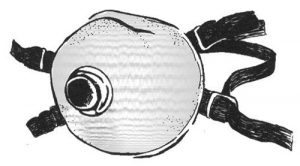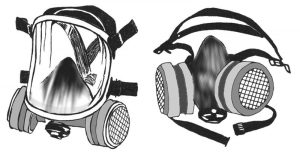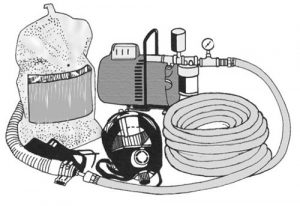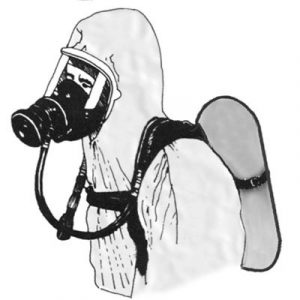Respirators and Pesticides I: The Right Respirator: Types, NIOSH Numbers, Filter Codes, and Cartridge Colors

Prepared by Kerry Bernard, Pesticide Safety Education Professional
Reviewed by Jason Lilley, Sustainable Agriculture Professional, and Jim Dill, Pest Management Specialist
UMaine Cooperative Extension Diagnostic and Research Laboratory, Pest Management Unit, 17 Godfrey Drive, Orono, ME 04473-3692, 207.581.3880 extension.diagnosticlab@maine.edu
The Right Respirator
Inhaled pesticides can damage the respiratory tract and may pass into the bloodstream within moments. The consequences range from minor nose and throat irritation to permanent disability, neurological damage, or death.
Not only is it a health risk, but when the pesticide label directs you to wear a respirator, it’s illegal to do otherwise. Not all respirators are suitable for all pesticides, users, or pesticide situations, however, and selecting one is far from straightforward. The codes used to identify the different respirator types and components can be confusing. Worse, some pesticide labels still use outdated respirator language.
The following graphics and descriptions should help demystify respirator terminology and classification.
| NIOSH prefix | Type(s) of respirator | Explanation |
|---|---|---|
| TC-84A |
|
Non-powered respirators with non-canister particulate filtering components get this prefix, regardless of chemical protection |
| TC-21C |
|
PAPRs that protect against particulates alone have their own approval standards |
| TC-23C |
|
Non-powered chemical respirators without a particulate filtering component to their cartridges and PAPRs with chemical protection get this prefix |
| TC-14G |
|
Non-powered respirators that take a canister instead of cartridges have their own prefix |
| TC-19C |
|
Airline respirator set-ups in which no escape tank is carried have their own prefix |
| TC-13F |
|
Atmosphere-supplying respirator setups where the user carries supplied-air get this prefix |
The Particulars of Particulates
Particulates, also known as aerosols, are tiny, solid or liquid particles suspended in the air. These include mists, dust, fumes, smoke, mold, and bacteria. Only filters protect against particulates. These filters come in nine types, depending upon how well they hold up against oils and the minimum percentage of particles they remove. P100 and HE (for PAPRs only) filters offer the most protection and are colored pink or purple for easy recognition. If a pesticide requires an N, R, or P class filter, but an adjuvant or another, the oil-based pesticide has been added to the mix tank, use an R or P class filter.
| Filter Efficiency | Not Oil-Resistant | Oil-Resistant | Oil-Proof |
|---|---|---|---|
| 95% | N95 | R95 | P95 |
| 99% | N99 | R99 | P99 |
| ≥ 99.97% | N100 | R100 | P100 |
Gases and Vapors
Some pesticides are gases or give off gases at ambient temperatures (vapors). Filters do not protect against these, but the sorbents and/or catalysts in cartridges and canisters can. Cartridges/canisters are color-coded by the type of chemical they protect against. No cartridge or canister can adsorb every type of gas or vapor, but some are designed to protect against two or more (not at once).
| Cartridge/canister/filter color | Type | Offers protection against: |
|---|---|---|
| Organic vapors | Most pesticide vapors, but NOT pesticide dust or mist | |
| Acid gases | Sulfur dioxide, hydrogen chloride, most disinfectants | |
| Organic vapors and acid gases | Both organic vapors and acid gases, but NOT AT ONCE | |
| Ammonia | Anhydrous ammonia and ammonia from livestock | |
| Multi-gas | Organic vapors, acid gases, ammonia, formaldehyde, others | |
| P100 or HE filter | Particulates — dust, mists, and fumes | |
| Organic vapors and particulates | The vapors, dust, and mists typical of most pesticides |
Air-Purifying Respirators (APRs)
Air-purifying respirators mechanically filter out particulate contaminants and/or adsorb gases and vapors as the air is drawn through filters, cartridges, or a canister. They cannot be used in oxygen-deficient atmospheres.

Filtering facepieces are disposable particulate APRs in which the entire facepiece serves as a filter. Though not elastomeric, they must be tight-fitting with a proper seal. As non-powered particulate APRs, they get the TC-84A NIOSH designation.
Nuisance Dust Masks
Though they strongly resemble filtering facepieces, nuisance dust masks are not respirators, are not NIOSH approved, and cannot provide adequate protection from pesticides. They only protect against nuisance levels of NON-TOXIC particles.

Reusable non-powered chemical cartridge and particulate APRs are tight-fitting respirators equipped with cartridges of activated carbon that adsorb gases and vapors, filters that mechanically prevent particulates from entering the facepiece, or combination cartridges with the components of both. NIOSH designates all non-powered respirators with only chemical cartridges as TC-23C and ALL non-powered respirators and cartridges with particulate protection as TC-84A. Since most pesticides for which respirators are used require some particulate protection, TC-84A respirators are more common. The facepieces for either can be half- or full-mask.
| Type | NIOSH prefix | Facepiece | Fit | Reusable | Protects against particulates | Oil resistant | Protects against OV | Protects against fumigants | For use in IDLH atmospheres | Requires fit test | Offers eye protection | Can be worn with facial hair | ⇑
⇑ ⇑ ⇑ ⇑ ⇑ ⇑ ⇑ ⇑ ⇑ Increasing protection ⇑ ⇑ ⇑ ⇑ ⇑ ⇑ ⇑ ⇑ ⇑ ⇑ |
|
|---|---|---|---|---|---|---|---|---|---|---|---|---|---|---|
| Atmosphere-Supplying Respirators | Self-contained Breathing Apparatus (SCBA) |
TC-13F | Hood/ helmet |
Loose | Yes | Yes | Yes | Yes | Yes | Yes | No | Yes | Yes | |
| Elastomeric | Tight | Yes | NO | |||||||||||
| Supplied-air Respirator (SAR) |
TC-19C | Hood/ helmet |
Loose | Yes | Yes | Yes | Yes | At lower than IDHL levels | At lower than TC-13F escape bottle necessary |
No | Yes | Yes | ||
| Elastomeric | Tight | YES | If full-mask | NO | ||||||||||
| Air-Purifying Respirators (APRs) | Gas Mask | TC-14G | Elastomeric | Tight | Yes | With combo canister | With P100 canister | With OV canister | Some, at very low levels | Emergency escape only | YES | Yes | NO | |
| Chemical Cartridge Respirators |
TC-23C | Powered hood/ helmet |
Loose | Yes | With HE filter | With HE filter | With OV cartridges | NO | NO | No | Yes | Yes | ||
| Powered elastomeric | Tight | YES | If full-mask | NO | ||||||||||
| Non-powered elastomeric | NO | NO | ||||||||||||
| Powered Particulate Respirators |
TC-21C | Hood/helmet | Loose | Yes | Yes | Yes, HE filters | NO | NO | NO | No | Yes | Yes | ||
| Elastomeric | Tight | YES | If full-mask | NO | ||||||||||
| Non-powered Particulate Respirators | TC-84A | Elastomeric | Tight | Yes | Yes | With R or P rating | With OV combo cartridges | NO | NO | YES | If full-mask | NO | ||
| Filtering Facepiece | No | NO | No |

Powered air-purifying respirators (PAPRs) force air through a filter and/or cartridge for the user, making it less strenuous to breathe than when wearing other APRs. They’re commonly outfitted with a loose-fitting helmet or hood instead of an elastomeric facepiece. This allows individuals who are unable to get a proper seal with tight-fitting respirators, or those with certain physical limitations, to use them. PAPRs are classified differently by NIOSH, depending upon whether they protect against gases and vapors (TC-23C) or particulates alone (TC-21C). TC-21C PAPRs are equipped with a high efficiency (HE) filter. TC-23C PAPRs have either a chemical cartridge or combination cartridge with both HE filter and chemical sorbent. PAPRs are typically much more expensive than non-powered APRs, but may be the only option for some individuals, including those with beards.

Gas masks are non-powered, elastomeric APRs that take a canister. With the proper canister, they protect from both pesticide particulates and vapors. Gas masks are more effective for longer than other non-powered APRs. Some fumigant labels allow their use at known, low-level chemical concentrations. They can be used to escape from IDLH (Immediately Dangerous to Life and Health) atmospheres in emergency situations, but the canisters become saturated too quickly under these conditions to be used in place of atmosphere-supplying respirators.
Atmosphere-Supplying Respirators
Atmosphere-supplying respirators must be used when the air is oxygen-deficient or too contaminated to safely filter/decontaminate. They provide clean, oxygenated air, either from a tank carried by the user (Self-Contained Breathing Apparatus), or through a line from a compressor (Supplied-Air Respirator). These are the only respirators that can be used safely when working with most fumigants or other pesticides at or above IDLH levels.
- Supplied-air respirator (SAR) — Illustration by Donald Barry
- Self-contained breathing apparatus (SCBA) — Illustration by Donald Barry
| if the label says… | The user should… |
|---|---|
| Dust/mist filtering | Use a particulate filter. |
| Pre-filter approved for pesticides | Use a combination of chemical cartridge-particulate filter. |
| Canister approved for pesticides | Use a gas mask with a canister labeled for the contaminant. For many pesticides, this will be a black organic vapor (OV) or black and pink OV-particulate canister. |
| Any N, R, P, or HE filter | Use a non-powered respirator with an N, R, or P filter, or a PAPR with a HE filter. |
| TC-21C | Check for obsolete language. TC-21C used to refer to any respirator with a particulate filter. Non-powered APRs with particulate filters are now designated TC-84A and TC-21C refers only to PAPRs without a chemical cartridge. |
| TC-23C | Check for obsolete language. TC-23C used to refer to any respirator with a chemical or combo cartridge. Non-powered APRs with combination chemical cartridge-particulate filters are now designated TC-84A while TC-23C only refers to PAPRs with a chemical cartridge. |
This material is meant as a general guide only. ALWAYS follow pesticide label and respirator manufacturer instructions. For more information on respirators and their use, see:
- NIOSH/CDC: cdc.gov/niosh, Email: cdc-info@cdc.gov, 800.232.4636
- OSHA: osha.gov, 800.321.6742
- EPA: epa.gov/pesticides, Email: pesticidequestions@epa.gov
- PERC: pesticideresources.org
- AgriSafe Network: agrisafe.org/lungs-for-life
- Maine BPC: thinkfirstspraylast.org, 207.287.2731
- UMaine Extension Professionals: Jason Lilley, jason.lilley@maine.edu, 207.781.6099, or Kerry Bernard, kerry.bernard@maine.edu, 207.581.3884
To download and print this brochure:
Disclaimer
Pesticide safety information may change over time. This information is provided for educational purposes only and was published in 2019.
Although pesticides can be an essential tool in pest management, the improper use and disposal of these chemicals present a continuing risk to humans, animals, and the environment. It’s important for applicators to understand that pesticide safety is not only about protecting themselves — it’s also about protecting our domestic and wild animals, the environment, our landscapes, and our communities.
Misuse of pesticides can result in, or contribute to, serious injury, illness, or death. Cooperative Extension does not guarantee the safety or effectiveness of any product or practice. Users of any pesticides, and Extension’s educational materials, do so at their sole risk and assume all risk from using such pesticides and materials, whether they follow recommendations or not. The user bears all responsibility for resulting damages to property, human health, or the environment. Cooperative Extension and the University of Maine System shall not be responsible for any damages including, but not limited to, any and all damage or loss to real or personal property, personal injury or death, resulting from the negligence of cooperative extension, the university, its trustees, faculty, agents, employees or volunteers.
Always follow directions on pesticide labels! Failure to do so violates federal law. Application timing and proper calibration are as important as using the right product.
Cooperative Extension makes no warranty or guarantee of any kind, expressed or implied, concerning the use of any stated products. Trade names are used for identification only; no product endorsement is implied, nor is discrimination intended.
Source material includes publications from EPA, CDC/ NIOSH, OSHA, Oregon OSHA, and PERC, and Cooperative Extension Offices from Pennsylvania State University, Rutgers University, University of Florida, and the University of Nebraska. Photos courtesy of USDA-ARS. Illustrations by Donald Barry.
The University of Maine is an EEO/AA employer and does not discriminate on the grounds of race, color, religion, sex, sexual orientation, transgender status, gender expression, national origin, citizenship status, age, disability, genetic information or veteran’s status in employment, education, and all other programs and activities. The following person has been designated to handle inquiries regarding non-discrimination policies: Director of Equal Opportunity, 101 North Stevens Hall, University of Maine, Orono, ME 04469-5754, 207.581.1226, TTY 711 (Maine Relay System).


